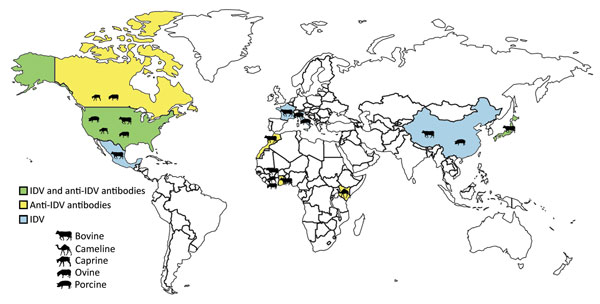Serologic Evidence for Influenza C and D Virus among Ruminants and Camelids, Africa, 1991–2015
Elias Salem, Elizabeth A.J. Cook, Hicham Ait Lbacha, Justine Oliva, Félix Awoume, Gilbert L. Aplogan, Emmanuel Couacy Hymann, Dishon Muloi, Sharon L. Deem, Said Alali, Zaid Zouagui, Eric M. Fèvre, Gilles Meyer, and Mariette Ducatez

Author affiliations: Interactions Hôtes Agents Pathogènes, Université de Toulouse, INRA, ENVT, Toulouse, France (E. Salem, J. Oliva, G. Meyer, M.F. Ducatez); International Livestock Research Institute, Nairobi, Kenya (E.A.J. Cook, D. Muloi, E.M. Fèvre); Institut Agronomique et Vétérinaire Hassan II, Rabat, Morocco (H.A. Lbacha, S. Alali, Z. Zouagui); Laboratoire Vétérinaire de Lomé, Lomé, Togo (F. Awoume); Laboratoire de Diagnostic Vétérinaire et de Sérosurveillance, Parakou, Benin (G.L. Aplogan); LANADA Central Laboratory for Animal Diseases, Bingerville, Côte d’Ivoire (E.C. Hymann); University of Edinburgh Centre for Immunity, Infection, and Evolution, Edinburgh, Scotland, UK (D. Muloi); St. Louis Zoo Institute for Conservation Medicine, St. Louis, Missouri, USA (S.L. Deem); University of Liverpool Institute of Infection and Global Health, England, UK (E.M. Fèvre)
Main Article
Figure 1

Figure 1. Locations where IDV or IDV antibodies had been detected as of April 2017. Species from which virus or antibodies were detected are indicated. IDV, influenza D virus.
Main Article
Page created: August 17, 2017
Page updated: August 17, 2017
Page reviewed: August 17, 2017
The conclusions, findings, and opinions expressed by authors contributing to this journal do not necessarily reflect the official position of the U.S. Department of Health and Human Services, the Public Health Service, the Centers for Disease Control and Prevention, or the authors' affiliated institutions. Use of trade names is for identification only and does not imply endorsement by any of the groups named above.
